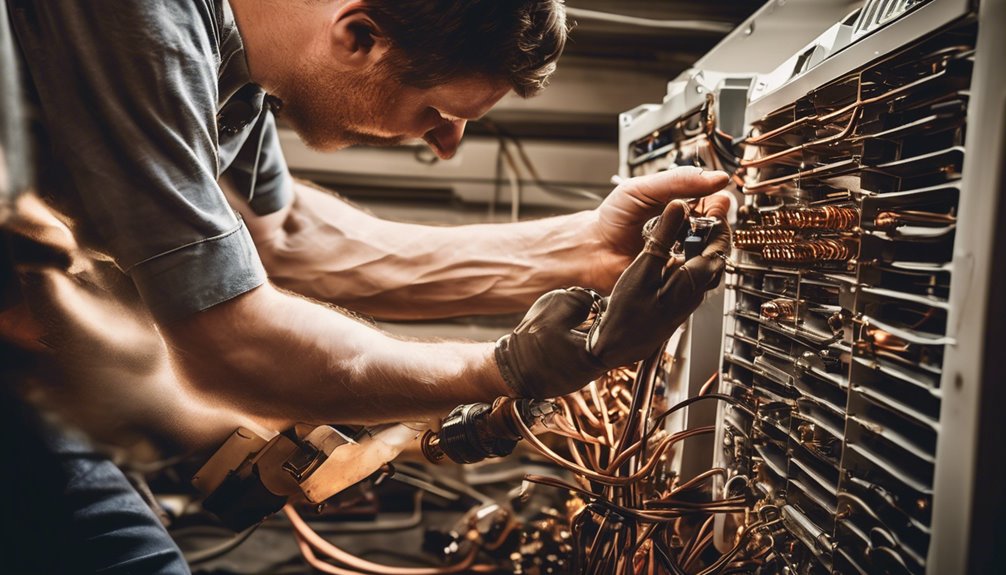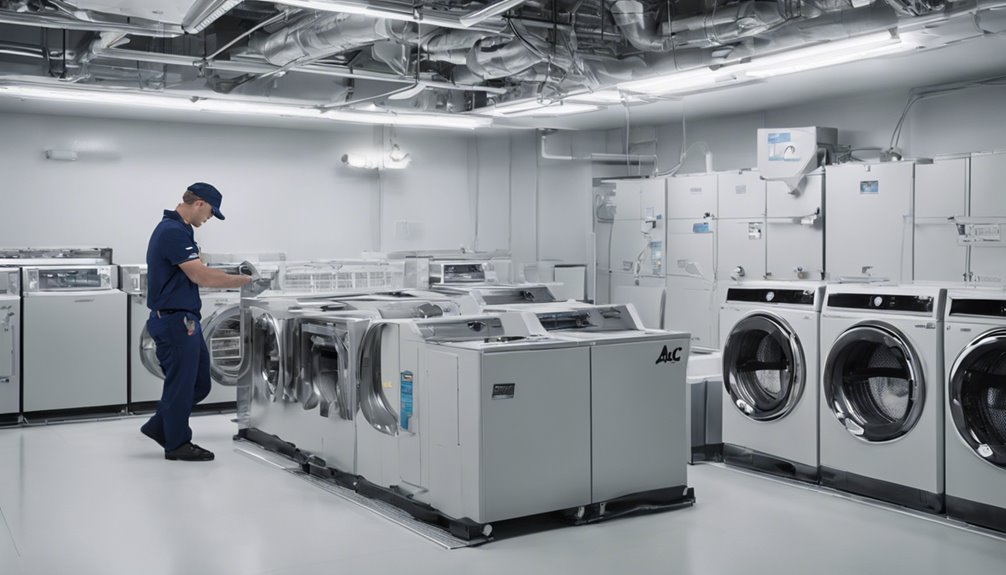When you call for AC repair, expect a comprehensive service that tackles the root cause of the problem. You'll get a thorough inspection and diagnosis to identify the issue, replacement of worn-out or damaged parts, and a filter cleaning or replacement. Your thermostat will also get a checkup and repair or replacement if needed. From there, the repair process will address refrigerant leaks and recharge your system as needed, ensuring your AC is functioning properly in the end. Want to know more about what goes into each step?
Key Takeaways
- AC repair includes identifying and diagnosing the root cause of the problem to ensure accurate and efficient fixing of the issue.
- Inspection and diagnosis involve examining internal components, performing electrical tests, and pinpointing faulty parts or systems.
- Repairing or replacing worn-out or damaged parts, such as fan motors, compressors, or refrigerant coils, is a crucial step in AC repair.
- Cleaning or replacing air filters is essential to maintain AC efficiency, improve indoor air quality, and reduce energy consumption.
- Thermostat repair or replacement, including calibration and upgrading, is necessary to ensure proper temperature control and energy savings.
Identifying the Root Cause of the Problem
What's causing your air conditioner to malfunction?
To identify the root cause of the problem, you need to perform system checks. Start by checking the power supply, thermostat, and circuit breakers to ensure they're functioning properly.
Next, inspect the air filters, condenser coils, and refrigerant levels to see if they're dirty, clogged, or low.
Fault isolation is key in this process. By systematically eliminating potential causes, you'll narrow down the possibilities and pinpoint the issue.
Systematically eliminate potential causes to narrow down possibilities and pinpoint the issue.
This step is crucial in AC repair, as it saves time and resources in the long run. By doing your due diligence, you'll be able to accurately diagnose the problem and plan the necessary repairs.
Inspecting and Diagnosing the Issue
With your system checks complete, you're now ready to delve deeper into the issue by inspecting and diagnosing the problem.
This involves a thorough examination of your AC unit's internal components, including the electrical system.
You'll perform electrical tests to identify any faulty wiring, tripped circuits, or overheated components.
These tests will help you pinpoint the source of the issue, whether it's a faulty capacitor, a malfunctioning thermostat, or something else.
By inspecting and diagnosing the problem, you'll have a clear understanding of what's wrong and can develop a plan to fix it.
This step is crucial in ensuring that the repair is done efficiently and effectively.
Replacing Worn-Out or Damaged Parts
Now that you've diagnosed the problem, it's time to replace the worn-out or damaged parts that are hindering your AC's performance.
This is a crucial step in the repair process, as faulty components can cause your air conditioner to malfunction or even break down entirely.
Part replacement is a key aspect of AC repair, and it may involve a component overhaul of the entire system.
You'll need to identify the faulty parts, whether it's a worn-out fan motor, a damaged compressor, or a leaky refrigerant coil.
Once you've replaced the defective parts, your AC should be back up and running smoothly.
Remember to always follow proper safety protocols and manufacturer guidelines when performing part replacements to ensure your safety and the longevity of your AC unit.
Cleaning or Replacing Air Filters
You'll want to inspect your air filters regularly to ensure they're not clogged with dirt and debris.
A dirty filter can lead to increased energy bills, reduced airflow, and even premature wear on your AC unit.
Filter Inspection Process
How often do you inspect and maintain your air conditioner's filters?
Regular filter maintenance is crucial for your AC's performance and efficiency.
During the filter inspection process, a technician will check the condition of your air filters, looking for signs of dirt, dust, and debris accumulation.
If your filters are dirty, they'll perform filter cleaning to remove any blockages.
If the filters are damaged or worn out, they'll recommend replacing them with new ones.
This process ensures your AC operates smoothly, providing clean air circulation and reducing energy consumption.
Dirty Filter Consequences
A dirty air filter can have far-reaching consequences on your air conditioner's performance and your indoor air quality.
When you neglect to clean or replace your air filter, it can lead to reduced filter efficiency, causing your AC to work harder and increase your energy bills.
Moreover, a dirty filter can circulate pollutants and allergens throughout your home, compromising your air quality.
This can aggravate respiratory issues, such as asthma, and even trigger allergic reactions.
By ignoring this crucial maintenance task, you're putting your health and wallet at risk.
It's essential to prioritize filter cleaning or replacement to ensure optimal AC performance, improved air quality, and a healthier living space.
Repairing or Replacing the Thermostat
Most homeowners take their thermostats for granted until they stop working properly, leaving them sweating in the summer or shivering in the winter.
When your thermostat malfunctions, it's essential to address the issue promptly to avoid discomfort and energy waste.
You may need to repair or replace your thermostat, depending on the severity of the problem.
In some cases, a simple thermostat calibration can resolve the issue.
However, if your thermostat is outdated or faulty, a thermostat upgrade may be necessary.
Here are some signs that indicate you need thermostat repair or replacement:
- Inconsistent temperatures
- Failure to turn on or off
- Unresponsive display
Addressing Refrigerant Leaks and Recharging
When you suspect a refrigerant leak in your AC unit, you'll need to identify the source of the problem.
You'll use various leak detection methods, such as ultraviolet dye or electronic leak detectors, to pinpoint the issue.
Once you've found the leak, you can begin the recharge process, which involves several crucial steps to ensure your AC is running efficiently and safely.
Leak Detection Methods
You'll need to identify the source of refrigerant leaks in your air conditioning system to effectively repair and recharge it.
To do this, technicians employ various leak detection methods.
Here are some common techniques:
- Ultrasonic testing: This method uses specialized equipment to detect the high-frequency sounds produced by escaping refrigerant.
- Infrared imaging: Thermal imaging cameras are used to visualize temperature differences, indicating where refrigerant is leaking.
- Soap bubble testing: A mild detergent is applied to suspected areas, and if bubbles form, it indicates a leak.
Recharge Process Steps
Now that you've identified the source of the refrigerant leak, it's time to address the issue and recharge your air conditioning system.
The recharge process involves evacuating the system, identifying the leak source, and repairing or replacing the faulty component.
You'll need to determine the type of refrigerant used in your system, such as R-410A or R-22, to ensure the correct replacement.
Once the leak is fixed, the system is recharged with the correct amount of refrigerant.
The technician will then test the system to ensure it's operating efficiently and safely.
Proper recharge is crucial to prevent further damage to your AC unit and prevent environmental harm from refrigerant leaks.
Testing and Ensuring Proper AC Functionality
A well-maintained air conditioning system is a vital component of a comfortable living space, and testing its functionality is crucial to ensuring it runs efficiently and effectively.
A well-maintained air conditioning system is key to a comfortable living space, running efficiently and effectively.
When you hire a professional to repair your AC, they'll perform a series of system checks to identify any issues.
This includes:
- Verifying thermostat settings to ensure the AC is receiving the correct signals.
- Checking refrigerant levels to detect any leaks or inadequate charging.
- Inspecting ductwork and vents for blockages, damage, or poor installation.
Frequently Asked Questions
Do I Need to Replace My Entire AC Unit if It's Old?
You don't necessarily need to replace your entire AC unit just because it's old; a system inspection can help identify specific issues, and you might be able to achieve cost savings by repairing or replacing individual components instead.
Can I Perform AC Repairs on My Own to Save Money?
You might be tempted to DIY AC repairs to save cash, but be aware that you're taking on DIY risks, like causing more damage or even voiding your warranty, which could end up costing you even more in the long run.
How Long Does a Typical AC Repair Service Call Take?
When you schedule an AC repair service call, you're probably wondering how long it'll take. Typically, it takes around 1-3 hours, but with rush service, you can get an emergency fix in as little as 30 minutes, depending on the complexity of the issue.
Will a New Thermostat Improve My Ac's Energy Efficiency?
You're wondering if a new thermostat will boost your AC's energy efficiency. The answer is yes! A smart thermostat with advanced smart sensors can detect temperature fluctuations, optimizing cooling and reducing energy waste, ultimately saving you money on your utility bills.
Are AC Repair Services Usually Available on Weekends or Holidays?
You'll be glad to know that many AC repair services offer weekend scheduling, and some even provide emergency availability on holidays, so you're covered in case your AC breaks down when you need it most.
Conclusion
You've got a handle on what's involved in AC repair. From identifying the root cause of the problem to testing and ensuring proper functionality, it's a thorough process. By inspecting and diagnosing the issue, replacing worn-out or damaged parts, cleaning or replacing air filters, repairing or replacing the thermostat, and addressing refrigerant leaks and recharging, your AC will be running smoothly in no time. You'll be back to enjoying cool comfort in your home or office with a job well done.



